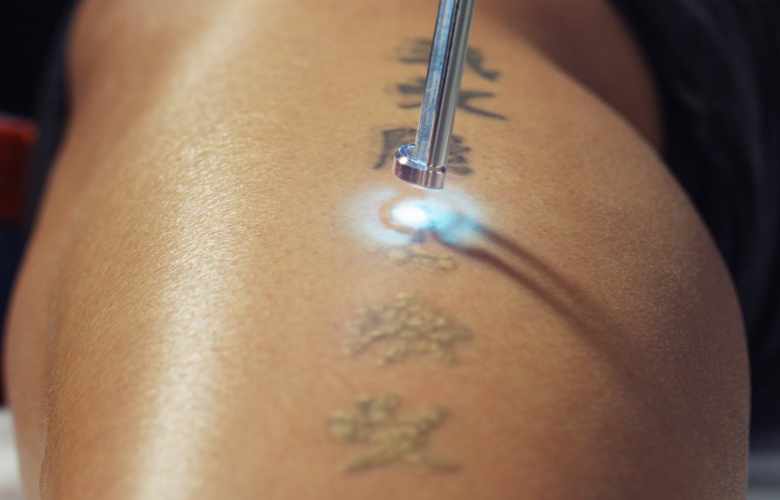Tattooing is at least as old as the late-Stone Age and appears in every corner of the world, so it reasons then that tattoo removal might have arisen not long after tattooing was introduced. However, most methods of tattoo removal were crude and left disfiguring scars if they were effective at all. A new approach was made available in 1960 when Theodore H. Maiman invented the laser, and laser tattoo removal work were developed within the decade. Many innovations in laser technology along the way improved the safety and quality of the procedure, making it fairly routine to “zap a tat” in the 21st century.
Why Use Laser Tattoo Removal?
The two main targets of laser tattoo removal are decorative tattoos and traumatic tattoos. Approximately one-quarter of North Americans have a decorative tattoo, but less than 20% of them are dissatisfied, and even fewer seek tattoo removal. There are many reasons why someone would want a decorative tattoo removed and these come down to very personal choices.
Some people get tattoos too young, a reversal in taste occurs, or the tattoo clashes with a lifestyle change. Gang tattoos can be seen as demonstrations of solidarity and similarly, tattooing a partner’s name may seem romantic at first, but it’s nice to know that a laser removal is an option if a partnership doesn’t work out.
One lesser-known reason why laser tattoo removal was developed is to treat traumatic tattoos. Traumatic tattoos can occur in civilian accidents and war casualties with tattooing from foreign bodies caused by land vehicle accidents, explosions, and gunshots. Fragments of metal and paint may be embedded in the skin in such accidents causing disfigurement. For many people, laser tattoo removal technology has importance beyond rectifying a youthful mistake.
Many forms of tattoo removal have existed for centuries including various techniques such as excisional surgery, dermabrasion, salabrasion, cauterization, and liquid nitrogen. Until laser tattoo removal, the least daunting approach to an unwanted tattoo was to cover it up with a larger tattoo. Unfortunately, a tattoo cover-up is not always possible, as it requires a larger and darker image to cover up the previous tattoo. Luckily, laser tattoo removal has come a long way from an experimental procedure to become a routine treatment.
What Does The Laser Do?
Laser tattoo removal is considered non-invasive because sweat glands and hair follicles are impervious to laser light and aid in the rapid regeneration of the epidermis in the treated area. Tattooed ink particles in the upper dermis range in diameter from 40 to 300 nanometers (nm). These tiny particles absorb laser light and this laser light is then converted to heat causing the ink particles to vaporize in a mechanism called photothermolysis, in which the vaporized pigment is then expelled from the tissues in a gaseous form. The lymphatic system subsequently removes some smaller ink particles as well.
The duration of a laser tattoo removal procedure varies depending on the size and placement of a tattoo. A laser session on a small tattoo can be completed within minutes, although larger tattoos with more shading and color variation can take hours as different lasers need to be switched for certain parts of the tattoo. Furthermore, a particularly large and dark tattoo will require multiple sessions with 6-week intervals.
Hand-poked tattoos have more scarring and depth variability than machine tattoos, which can lead to complications in laser treatment. Additionally, darker skin tones absorb more laser light, making tattoos on darker skin more difficult to treat. To address these problems, laser effectiveness has improved over the years by modifying the type, size, and pulse duration of laser treatments.
The first lasers to be used for tattoo removal were the argon laser and carbon dioxide laser. These continuous-wave lasers left scarring and the blue-green combination spectrum was ineffective against certain types and colors of ink. Shortly after Maiman’s laser was introduced, the quality-switched laser (Q-switched) was developed to create controlled pulses of light that are much less invasive than continuous-wave lasers. Neodymium glass (Nd:YAG) and ruby q-switched lasers are now most commonly used to treat the spectrum of inks found in tattoos.
Side Effects
The most immediate side effect of laser tattoo removal may be pain from the laser. Lidocaine or another topical cream is sometimes applied as a local anesthetic, but once this wears off the patient may experience a sunburn-like sensation in the treated area for a few days and general sensitivity in the area for a few weeks. Long-term side effects are determined by the tattoo placement and laser used for the treatment. More serious reactions include hypopigmentation (lightened skin), hyperpigmentation (darkened skin), texture changes, and hypertrophic scarring were common problems of older argon and CO2 laser treatment, but this is less common with recent technology.
Hello, I am a professional writer, with more than 10 years of writing experience. I love to write on the science related subjects and share knowledge with my readers. I hope all my reader friends will enjoy my work.

